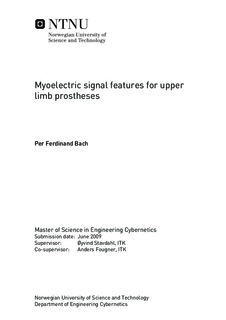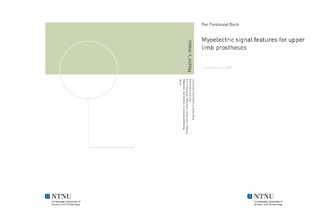| dc.contributor.advisor | Stavdahl, Øyvind | nb_NO |
| dc.contributor.advisor | Fougner, Anders | nb_NO |
| dc.contributor.author | Bach, Per Ferdinand | nb_NO |
| dc.date.accessioned | 2014-12-19T14:01:55Z | |
| dc.date.available | 2014-12-19T14:01:55Z | |
| dc.date.created | 2010-09-03 | nb_NO |
| dc.date.issued | 2009 | nb_NO |
| dc.identifier | 347759 | nb_NO |
| dc.identifier | ntnudaim:4498 | nb_NO |
| dc.identifier.uri | http://hdl.handle.net/11250/259756 | |
| dc.description.abstract | In the last couple of years The Institute of Cybernetics at NTNU, Norway, has based its research on the SVEN work carried out in Sweden in the late 1970’s. The SVEN hand was an on/off-controlled upper limb prosthesis based on electromyographic (EMG) signals. This master thesis is a part of the renewed and continuing research. This study will try to identify signal features that are beneficial in a proportional control of a multi-function upper limb prosthesis. The intent is to identify a set of signal features that could be implemented in a practical proportional control system to enhance the movement functions of the prosthesis such that it more closely mimic the movements of a normal upper limb. The data set used in this paper consist of EMG signals and VICON angle data recorded by Fougner (2007). A short explanation will be given on how to acquire such data. A brief introduction on feature selection defines the properties of a wrapper and filter approach in search for a feature subset. Wavelets properties are explained and two wavelet techniques are used in order to obtain more information from the EMG signal in addition to existing features. From this, we search for a subset of features that will let us use a mapping function that estimates a correct motion with respect to the features fed to it. The Cosine Similarity Transform (CST) and the Correlation coefficient (CORR) will in addition to RMSE be investigated in order to find an optimal performance indicator. With a good and reliable indicator we may find a suitable subset. EWC-WAVE were found to be the best subset according to both CST and RMSE. Based upon the information obtained from each performance indicator, it is suggested that CST should be carried out as a measure of accuracy on how to map data in the future. There are still unsolved problems. Some of the angles we tried to estimate with a neural network suffered and produced non-informative data. This indicate that one should add more hidden nodes to a neural network when more features are used as input. We have obtained indications that we do need to combine feature subsets in order to obtain higher accuracy of the estimated signal. It is proposed that a post-processing technique should be developed and used subsequent to the pattern recognition methods in order to achieve a signal that better reflects the estimation and may be used as a control signal for a prosthesis. Hopefully will these findings help improve future work to achieve an enhanced proportional control for a real prosthesis. | nb_NO |
| dc.language | eng | nb_NO |
| dc.publisher | Institutt for teknisk kybernetikk | nb_NO |
| dc.subject | ntnudaim | no_NO |
| dc.subject | SIE3 teknisk kybernetikk | no_NO |
| dc.subject | Industriell datateknikk | no_NO |
| dc.title | Myoelectric signal features for upper limb prostheses | nb_NO |
| dc.type | Master thesis | nb_NO |
| dc.source.pagenumber | 119 | nb_NO |
| dc.contributor.department | Norges teknisk-naturvitenskapelige universitet, Fakultet for informasjonsteknologi, matematikk og elektroteknikk, Institutt for teknisk kybernetikk | nb_NO |

